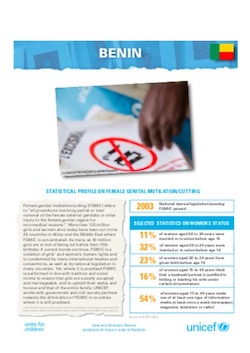Home | Research & Resources | Benin
Key Findings
The prevalence of FGM/C among women aged 15–49 in Benin is 9.2%.
86.3% of women aged 15–49 who are aware of FGM/C believe the practice should not continue.
Place
The departments with the highest prevalence are in the north; of Benin's 12 departments, five have a prevalence of less than 1%
Age
85.3% of women aged 15–49 who have undergone FGM/C were cut before the age of 15
Type
‘Flesh taken’ is the most common type of FGM/C practised
Agent
Almost all FGM/C is carried out by ‘traditional agents’ (including traditional cutters and birth attendants)
Distribution of FGM/C across Benin
The departments in Benin with the highest FGM/C prevalence are in the north: Borgou (37.6%), Alibori (23.7%) and Donga (36.8%). There is a significant difference between these departments and the rest of Benin: all remaining departments have a prevalence of below 10%; five of these (Atlantique, Couffo, Mono, Oueme and Zou have a prevalence of less than 1%. The department with the lowest prevalence is Couffo, in which no instances of FGM/C were recorded. FGM/C is more common in women living in rural areas (13.1%) than in those living in urban areas (5.2%).
FGM/C appears to be practised more by Muslims than by people of other religions, and there is a wide variation in levels of practice between ethnic groups: over 40% prevalence among the Bariba and Peulh, and less than 1% among the Adja and Fon.
Trends in FGM/C Prevalence in Benin
Between 2006 and 2011/12, the overall prevalence among women aged 15–49 fell from 12.9% to 7.3%. In 2014 the prevalence was recorded as 9.2%. Due to statistical fluctuations in the data, however, the most recent measurement of prevalence is unlikely to reflect a true increase.
Due to the large age-range of women included in the DHS and MICS surveys, the overall prevalence alone may not fully reflect the progress that has been made in recent years. Breaking down the most recent data by age group shows that the prevalence among women aged 45–49 is 18.1%, while for the youngest age group this has fallen to just 2.4%. Despite the fact that a small proportion of women may be cut after the age of 15, the data demonstrates a clear trend towards a lower prevalence among younger women.
FGM/C Legislation in Benin
The main law prohibiting FGM/C is Law no. 2003-03 on the Suppression of Female Genital Mutilation in the Republic of Benin, which was issued in March 2003. There is a lack of evidence, however, of any FGM/C cases being prosecuted under this law.
Development Indicators
Population Growth
12,427,818 (as of 8 June 2021), with a 2.69% growth rate (2021 est.)
Infant Mortality
31 deaths per 1,000 live births (2019)
Maternal Mortality
397 deaths per 100,000 live births (2017)
SDG Gender Index
109 out of 129 countries (2019)


_english.jpeg)
_english.jpg)
_cover.jpg)
_french.png)
_english_cover.jpg)
_french_cover.jpg)
_french.jpeg)
_french.jpg)

_cover.jpg)